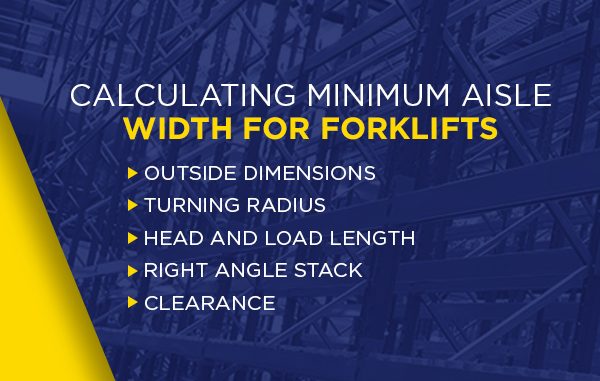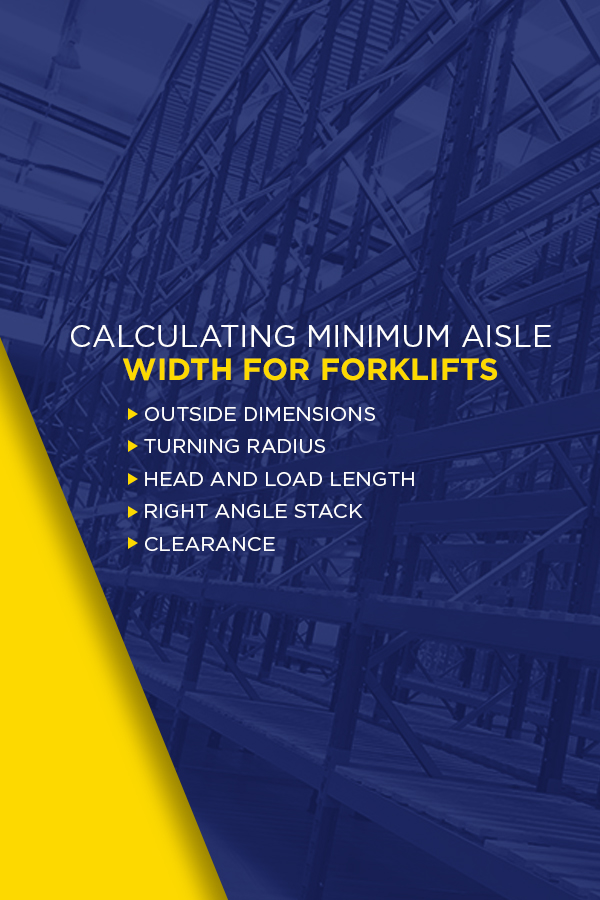Calculating Minimum Aisle Width for Forklifts

Determining the minimum aisle width in your warehouse is a crucial decision. You certainly don’t want to give up valuable space by making your aisles unnecessarily wide. However, it would be a disaster to set your racking and shelving components too close together.
Calculating the minimum aisle width for forklift travel and operation is a compromise. You need to know your exact forklift parameters and what absolute physical requirements they require to function within. That starts by being familiar with your forklift characteristics. Here is the primary information you must consider about your forklifts before you can comfortably calculate the minimum aisle width they can fit in.

- Outside dimensions: Forklifts are three-dimensional machines. They have fixed lengths, widths and heights. Forklift height is not usually an obstacle to setting minimum aisle widths. Some forklifts can reach 30 or more feet with their mast fully extended. However, your forklift’s length and width represent restrictions. The most restrictive measurement is its width, as this is the bare minimum aisle size it can pass through.
- Turning radius: If you’re operating a sit-down counterbalance forklift, you need to compensate for the circle it needs to turn within. By design, most forklifts have a tight turning radius. That’s especially so with three-wheel models. But even if your forklift can turn within its footprint, that will be at least the measurement of its length. Most forklifts are naturally longer than their width, and much of this is because of the tine or fork extensions.
- Head and load length: Designers and manufacturers calculate forklift length through two measurements. First is the head length. That’s the physical boundary between the machine’s rear and the face of the mast where the forks start. The second measurement is the load length, which is not only how far forward the metal forks protrude. Load length includes the maximum size of the pallet or other loads the forklift handles.
- Right angle stack: This measurement allows for the bare minimum your forklift needs to move a pallet from the pick or place position to a run configuration where the machine and load can safely navigate the aisle. As you can appreciate, the right angle stack adds to the outside dimensions and turning radius, as well as the head and load length. Here is where narrow aisle forklift designs conserve critical space by way of their plan and purpose. However, there are always some allowances to make for right angle stack when calculating minimum aisle width.
- Clearance: No matter how carefully and precisely you calculate your forklift’s maximum measurements, you still need to allow some clearance before you fix your minimum aisle width measurements. Clearance is a safeguard. There is no set formula for it. It’s a better-safe-than-sorry figure, and it takes in an allowance for inevitable operator error. The suggested clearance rule of thumb from material management experts is to give yourself at least one foot of clearance.
Deciding How Wide Your Warehouse Aisles Should Be

One foot of clearance sounds like a lot of extra room when you’re striving for maximum efficiency in minimum aisle layouts. In very narrow aisle warehouses, the foot of clearance could extend a five-foot aisle to six feet. That’s a 20 percent increase in space, and that sounds like a lot of expensive room to give up.
You should always err on caution’s side when deciding how wide your warehouse aisles should be. You need to start with your mobile equipment’s limitations before setting your fixed material handling products in place. It’s much easier to put your pallet racks or storage and shelving units in a safe position than it is to go out and purchase new material handling equipment to accommodate narrow warehouse aisles.
It makes good sense to narrow your aisles to a minimal size where your mobile equipment still functions. It is one of the best strategies to make the highest and best use of your storage space. However, calculating the minimum aisle size can be tricky. The best approach you can take is working with a nationwide distributor of storage products and material handling equipment.
Contact T.P. Supply Co for Storage Solutions
T.P. Supply is one of North America’s top storage solutions providers. Since 1979, we’ve served the United States, Canada and Mexico with superb customer service and professional-grade products to outfit warehouses across the continent. Our warehouse racking, bulk rack, material handling, storage and shelving and safety and security products will make your warehousing tasks more efficient and economical, not to mention being a safer workplace for your employees.
View Our Pallet Rack Solutions
At T.P. Supply, we can even help design your warehouse layout. That includes expert services in calculating your minimum aisle widths. Here’s what you can expect when working with T.P. Supply’s warehouse design service:
- Communicating with a warehouse design expert
- Arranging an in-depth meeting to discuss client needs
- Meeting to review and discuss the proposed design/layout
- Receiving a guaranteed quote for materials
- Considering the option for T.P. Supply professional installation
- Signing off on a quotation and setting a delivery/installation date
- Beginning actual material delivery and installation work
- Signing off on the completed project
Although T.P. Supply will design and build you a maximum-capacity warehouse system that implements narrow and very narrow aisle configurations, we want to stop and caution you on a crucial point. No matter how tight you make your warehouse aisles, you can only go so far. Your forklifts have to safely navigate your warehouse corridors, and your staff has to efficiently pick orders. If you exceed the maximum capacity rule, you’ll be too congested.
When you buy from T.P. Supply, you get a complete package. We can provide you with your materials in three different conditions to meet your budget: new, used or reconditioned. We deliver on trucks we own, and provide installation of your materials using our in-house installation crews. We do not contract out any work, and we are entirely self-contained.
Call T.P. Supply today and talk with our design experts about minimizing your warehouse aisle widths and maximizing your storage capacity. We’re at, or you can reach us through our online contact form.


